Notices
Copying or reprinting this manual in part or in whole without permission is prohibited.
Product names, registered trademarks and company names in this document are the property of their respective companies. All trademarks and registered trademarks in this document are for identification purposes only and are not intended to infringe on the copyrights of their respective owners.
Proper display is not possible on grayscale devices.
Notes about this Operation Manual
The contents of this document and the specifications of the product could be changed without notice.
Windows® is a trademark or registered trademark of Microsoft® Corporation.
iPhone, iPad, iPadOS and Mac are trademarks of Apple Inc.
App Store is a service mark of Apple Inc.
iOS is a trademark or registered trademark of Cisco Systems, Inc. (USA).
Android™ and Google Play are trademarks or registered trademarks of Google LLC.
The microSDXC logo is a trademark.
The Bluetooth® word mark and logo are registered trademarks of Bluetooth SIG, Inc. and these marks are used under license by ZOOM CORPORATION.
The terms HDMI and HDMI High-Definition Multimedia Interface, and the HDMI Logo are trademarks or registered trademarks of HDMI Licensing Administrator, Inc. in the United States and other countries.
Other product names, registered trademarks and company names in this document are the property of their respective companies.
All trademarks and registered trademarks in this document are for identification purposes only and are not intended to infringe on the copyrights of their respective owners.
Recording from copyrighted sources, including CDs, records, tapes, live performances, video works and broadcasts, without permission of the copyright holder for any purpose other than personal use is prohibited by law. ZOOM CORPORATION will not assume any responsibility related to infringements of copyrights.
The illustrations and display screens in this document could differ from the actual product.
Functions of parts
Back (display closed)
- Display (LCD)
- This shows the video and various types of information.
- Function buttons
- Use these to operate the functions shown on the display.
- DISP/Check button
- Change what is shown on the Recording Screen and Playback Screen. Use this to confirm operations on confirmation screens.
- Play button
- Use this to play files recorded by the Q8n-4K.
- Settings/Exit button
- Use this to open and close the SETTINGS Screen, for example. Use this to cancel on setting and confirmation screens.
Back (display open)
- Power button
- This turns the power on/off.
- PAD switch
- This attenuates the input signals of equipment connected to Inputs 1/2 by 20 dB.
- PHANTOM switch
- This turns Input 1/2 phantom power ON/OFF.
The phantom power voltage can be set to +12 V / +24 V / +48 V.(→ Using phantom power)
- Channel buttons
- These turn each channel on/off.
- microSD card slot
- Insert a microSD card here.
Left side
- Mic capsule
- Other mic capsules can be swapped for different applications.
- UNLOCK button
- Press in to enable moving the mic arm.
- Battery cover
- Remove this when installing or removing a battery.
Right side
- Inputs 1/2
- Connect mics and instruments to these. These can be used with XLR plugs.
- Input volume 1/2
- These adjust input volumes.
- Output volume
- This adjusts output volume.
- Strap holes
- Use these to attach a strap.
- Headphone output jack
- This can output sound to headphones.
- Micro HDMI port
- This can output video and audio to an HDMI-compatible TV or other device.
- USB (Type-C) port
- Connect this to a computer or iOS/iPadOS device to use the Q8n-4K as a web camera, card reader or USB mic.
A dedicated AC adapter (ZOOM AD-17) can also be connected here to use AC power. Connecting this when the power is off will charge the battery.
Front
- Lens
- This lens has F2.8 brightness and a 150º wide angle.
- REMOTE connector
- Connect a BTA-1 or other dedicated wireless adapter here. This enables operation of the Q8n-4K from an iOS/iPadOS/Android device using a dedicated controller app.
Top
- Mic input volume
- This adjusts the mic input volume.
- Speaker
- This outputs the sound of files and the beep.
- Record button
- This starts and ends recording video/audio.
Bottom
- Tripod mounting threads
- Use these screw threads to attach a tripod (not included).
Preparations
Installing the battery
Recharging the battery
About the mic arm
Raising the mic arm
While pressing, raise the mic arm until it reaches the fixed position.
Lowering the mic arm
While pressing, lower the mic arm.
Inserting microSD cards
Turning the power on/off
Turning the power on
Turning the power off
When Auto Power Off is set to on, the power will be turned off automatically after a certain period of time.
Setting up when first turned on (language setting / date and time setting)
Language setting / date and time setting screens automatically appear when first turned on or when first turned on after being reset.
Connecting
Connecting / disconnecting mic capsules
Connecting mic capsules
Push a mic capsule into place until it locks.
Disconnecting mic capsules
While pressing the buttons on the left and right sides of the mic, pull it out of the unit.
Do not use too much force when disconnecting. Doing so could damage the mic capsule and the unit.
Recording will stop if a mic capsule is removed during recording.
Connecting mics / instruments / mixers
You can connect mics, mixers, and other instruments to Inputs 1 and 2 of the Q8n-4K. The L/R input from the mic capsule and Inputs 1/2 can be used together to record up to 4 channels at the same.
Concert video recording
- L/R input
- This records the sound of the entire concert hall.
- Inputs 1/2
- Connect to the line outputs from the PA mixer to record the clear sound of instruments and vocals.
- PA mixer
Guitar performance video recording
- L/R input
- This records the sound of the room where vocals and guitar are combined.
- Input 1
- Connect to a vocal mic to record a clear singing voice.
- Input 2
- Connect to a guitar mic to record clear sound.
- Guitar mic
- Vocal mic
Phantom power (+12 V / +24 V / +48 V) can be supplied to condenser mics.
Adjusting audio (setting input/output)
Enabling channels to record
Using phantom power
Inputs 1/2 support phantom power. They can supply power at +12 V / +24 V / +48 V.
To turn phantom power on, slideto the ON side.
Setting phantom power voltage
Adjusting recording (input) levels
When using a mic capsule
Turn.
When using Inputs 1/2
Turnon the right side of the unit.
If an input clips, the button indicator for the channel button will blink. Adjust the level so that the indicator does not blink even when loud sounds are input.
Using the PAD function
Turn the PAD function on by slidingto the −20dB side to allow connection of mixers and other devices with a rated output level of +4 dB.
Mixer Screen
The Mixer Screen cannot be displayed during recording / web camera use.
Reducing noise (low frequency cut)
You can reduce the sound of wind, vocal pops and other noise.
Setting effects (Comp/Limiter/Gate)
You can record clearer sound by adjusting the volume according to the input signal level.
Recording
Recording Screen
- Available recording time
- This shows the available recording time.
- Remaining battery level
- This shows the remaining battery level. When the remaining battery level is low, charge the battery or connect the AC adapter.
- Recording mode
- This shows the current recording mode.
- Resolution
- This shows the current resolution.
- Frame rate
- This shows the current frame rate.
- Recording format
- This shows the current recording format.
- Field of view
- This shows the current field of view.
- Scene setting
- This shows the current scene setting.
- Brightness
- This shows the current brightness.
- Clip indicators
- If a clip indicator lights, adjust the input level or Mixer level, or set the Limiter.
- Channels
- These show the ON/OFF status of each channel. If a channel blinks, adjust the input level.
- Level meters
- These show the level (post fader) of each channel.
Selecting a recording mode
You can change the recording mode on the Recording Screen.
The WAV file for each channel is a recording of audio that is not affected by the Mixer PAN / LEVEL / FX / LOCUT settings.
Setting the video recording format
Setting the resolution
Setting the frame rate
Setting the audio recording format
You can change the audio recording format on the Recording Screen.
Adjusting the video quality
You can adjust the video quality on the Recording Screen.
Adjusting the field of view
Selecting a scene
Adjusting the brightness
Starting recording
Using the Self Timer function
You can set the Self Timer on the SYSTEM Screen.
Playing recordings
Starting playback
Only video and audio files recorded with the Q8n-4K can be played back.
Playback Screen
- Playback status
- This shows the current playback status.
- Remaining battery level
- This shows the remaining battery level. When the remaining battery level is low, charge the battery or connect the AC adapter.
- File information
- This shows information about the playing file.
- Repeat setting
- Change the repeat setting.
- File selection
- Select a file to play back.
- File number
- This shows the file number being played back / total number of files.
- Playback position search
- Search backward and forward for the playback position.
- File deletion
- Delete a file being played back.
- Audio channel selection
- Select the audio channel to play back.
- File name
- This shows the name of the file being played back.
- Level meters
- These are the level meters for the audio from the selected channels.
- Playback position
- This shows the current playback position, elapsed time, and video length.
After a certain period of time from the start of playback, icons will automatically disappear from the previous screen. If you want to show them again, press.
Playback operations
The following operations are possible during playback.
| Button | Explanation |
|---|---|
| Skip 10 seconds forward. Press and hold to search forward. | |
| Skip 10 seconds backward. Press and hold to search backward. | |
| Skip to the next file. | |
| Skip to the previous file. | |
| Pause / resume playback. |
When the length of the file to be played back is no more than one minute, pressing /
skips one second forward / back one second.
Enabling continuous playback
Continuous playback can be set on the Playback Screen.
Changing the audio channel for playback
When playing a file recorded in MOV+WAV or WAV (MULTI) format, you can change the audio channel for playback on the Playback Screen.
Managing files
Displaying file information
File information can be shown on the Playback Screen.
Deleting files
You can delete files that are playing back or stopped on the Playback Screen.
Using USB functions
Connecting to a computer or iOS/iPadOS device
Use a USB cable to connect to a computer or iOS/iPadOS device and use the Q8n-4K as a web camera, card reader or USB mic.
Turning the power on when connected to a computer
The USB setting Screen will appear.
You can use a USB function by selecting the corresponding item.
To open the Recording Screen, press or
or.
Using as a web camera
You can use the Q8n-4K as a web camera to output audio and video signals to a computer.
Compensating for lags between video and audio
If a timing difference occurs between the video and audio when using the recorder as a web camera, you can set an audio delay time so that it matches the timing of the video.
Using as a USB mic
The Q8n-4K can be used as a USB mic to input audio to a computer or iOS/iPadOS device.
Enabling direct monitoring
The input sound can be monitored directly during web camera use or USB mic use.
Managing files recorded on the SD card.
The Q8n-4K can be used as a card reader to read and write data from computers and iOS/iPadOS devices.
Managing SD cards
Checking SD card information
You can check the free space and size of microSD cards.
Formatting SD cards
Operating from an iOS/iPadOS/Android device
Connecting an iOS/iPadOS/Android device
When a dedicated wireless adapter (e.g. BTA-1) is connected, the Q8n-4K can be operated from an iOS/iPadOS/Android device using the dedicated Q8n Control app.
The Q8n Control app must be installed on the iOS/iPadOS/Android device in advance. The Q8n Control app can be downloaded from the App Store or Google Play.
For app setting and operation procedures, see the manual for the Q8n Control app.
Disconnecting from the iOS/iPadOS/Android device
Using connected to a TV / monitor by HDMI
Use an HDMI cable to connect with a TV / monitor to view the Q8n-4K video recordings on it.
You can play / stop the recorded video by using the remote control of the HDMI-CEC-compatible TV.
Checking the Recording Screen on an HDMI-compatible TV / monitor
You can view Q8n-4K video recordings on a TV / monitor by using an HDMI cable.
If you connect an HDMI cable (commercially-available) to the Micro HDMI port , you can view Q8n-4K video recordings when the Recording Screen is open.
- Available recording time
- This shows the available recording time.
- Remaining battery level
- This shows the remaining battery level. When the remaining battery level is low, charge the battery or connect the AC adapter.
- Color buttons
- Use the TV remote control red button to change the screen display and use the yellow button to play the video.
Playback on an HDMI-compatible TV / monitor
You can view Q8n-4K video recordings on a TV / monitor by using an HDMI cable.
Setting the unit
You can make various settings for the Q8n-4K on the SYSTEM Screen.
Setting the volume of the operation sound (Beep)
Set the volume of the Q8n-4K operation sound.
Enabling Power Saving
Setting the display backlight time
Power can be saved by shortening the amount of time that the backlight stays lit.
Setting the Auto Power Off function
Set the unit to turn off automatically if not used at all for a set amount of time when running on battery power.
This function is disabled during recording and playback as well as when it is powered through its USB port.
Setting the date and time
If the date and time are set, you can add the recording date and time to files.
Setting the language shown
Set the language shown on the display.
Restoring default settings
You can restore all Q8n-4K settings to their factory defaults.
Managing the firmware
Checking the firmware versions
The firmware versions used by the Q8n-4K can be checked.
Updating the firmware
The Q8n-4K firmware can be updated to the latest versions.
The latest firmware update file can be downloaded from the ZOOM website (zoomcorp.com).
Refer to Q8n-4K Firmware Update Guide on the Q8n-4K download page.
Mic capsule information
Checking mic capsule information
Using optional mic capsules
The Q8n-4K allows mic capsules to be switched for different circumstances.
When using optional mic capsules, there is basically no difference in the display and operation from when using the included mic capsule. However, you can change settings specific to each mic capsule.
The table below shows which mic capsules are compatible with the Q8n-4K.
| Mic capsule | Description | Compatible with the Q8n-4K | |
|---|---|---|---|
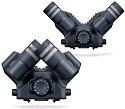 | XAH-8 | XY-AB stereo mic | ✔ |
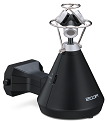 | VRH-8 | Ambisonic VR mic | ✔ |
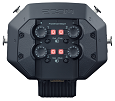 | EXH-8 | 4-channel XLR input | Not compatible |
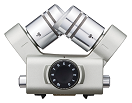 | XYH-6 | 90/120º angle-switchable XY stereo mic | ✔ |
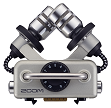 | XYH-5 | XY stereo mic with shock mount | ✔ |
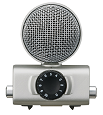 | MSH-6 | Mid-side stereo mic | ✔ |
 | SSH-6 | Mid-side stereo shotgun mic | ✔ |
 | SGH-6 | Shotgun mic | ✔ |
 | EXH-6 | 2-channel XLR/TRS input | ✔ |
Using the XAH-8
 | The XAH-8 is a stereo mic capsule that can use two stereo formats ("XY" and "AB"). There is basically no difference in the display and operation from when using the included mic capsule. |
Using the VRH-8
 | The VRH-8 is an Ambisonic mic capsule that can capture 360º audio recordings with four mics to produce vertical spread and front-back depth. It supports three audio recording formats: AmbiX, FuMa and Ambisonics A. |
Available audio recording formats
- 48 kHz/24-bit
- 48 kHz/16-bit
- 44.1 kHz/24-bit
- 44.1 kHz/16-bit
Available recording modes
- MOV+WAV
- WAV(MULTI)
Audio channels that can be played back
- MIXED: audio of stereo mixdown selected during recording
- Ambix/FuMa/Ambisonics A: W channel audio (Omni)
The VRH-8's mic position is fixed at upright.
INPUT 1 and INPUT 2 jacks are disabled.
Changing audio recording formats
You can set the audio recording format to AmbiX, FuMa or Ambisonics A.
Changing stereo mixdown modes
You can select a mixdown mode for stereo audio files when using the VRH-8.
| Mixdown mode | Explanation |
|---|---|
| 360º OMNI | This outputs a mono mix of sound from all directions. |
| 90º STEREO | This outputs stereo sound from the front 90º. |
Using the XYH-6
 | The XYH-6 is an XY stereo mic capsule that allows you to set the angle between mics to 90º or 120º. The XYH-6 also has a MIC/LINE IN input jack (that supports plug-in power) to input sound from external devices. |
Using plug-in power
Make the following setting when a mic that supports plug-in power is connected to the MIC/LINE IN input jack of the mic capsule.
Using the XYH-5
 | The XYH-5 is an XY stereo mic capsule equipped with a shockmount mechanism. The XYH-5 also has a MIC/LINE IN input jack (that supports plug-in power) to input sound from external devices. |
Using plug-in power
Make the following setting when a mic that supports plug-in power is connected to the MIC/LINE IN input jack of the mic capsule.
Using the MSH-6
 | The MSH-6 is a mid-side stereo mic capsule with a forward-facing, unidirectional mic (mid) and a side-facing, bi-directional mic (side). You can change the stereo width freely by adjusting the MS side level. |
Adjusting the side level
You can set the side level (stereo width) from 0º (mono) to 150º in 30º increments when using the MSH-6.
Using the SSH-6
 | The SSH-6 is a mid-side stereo mic capsule that includes a super-directional shotgun mic (mid) for picking up sound from the center and a bidirectional mic (side) for picking up sounds from the left and right. You can change the stereo width freely by adjusting the side level. |
Adjusting the side level
You can set the side level (stereo width) from 0º (mono) to 150º in 30º increments when using the SSH-6.
Using the SGH-6
 | The SGH-6 is a mono shotgun mic capsule with a super-directional mic that suppress ambient noise and focuses on the desired sound. Mono audio is input to L/R MIC channels. There is basically no difference in the display and operation from when using the included mic capsule. |
Using the EXH-6
 | The EXH-6 is an XLR/TRS combo capsule that provides additional external inputs for two channels. Signals from dynamic mics, line-level instruments, mixers and portable music players, for example, can be input through it. |
Mixing stereo signals to mono
When using the EXH-6, you can mix the inputs of its two channels to mono.
When Mono Mix is ON, a mono mix of the audio from both EXH-6 external inputs will be sent to both MIC L/R channels.
Troubleshooting
There is no sound or output is very quiet
Check the connections with connected output devices and their volume settings.
Confirm that the Q8n-4K volume is not set low.
Recorded sound cannot be heard or is very quiet
If you are using a mic capsule, confirm that the input level settings are suitable and that it is oriented correctly. (→ Adjusting audio (setting input/output))
Check the input level settings. (→ Adjusting audio (setting input/output))
If another device is connected to an input jack, raise the output level of that device.
If a condenser mic is connected to an input jack, check the phantom power and phantom power voltage settings.(→ Using phantom power)
If using an input jack, confirm that PAD is set appropriately. (→ Using the PAD function)
Recording audio/video is not possible
Confirm that the button indicators for the channels to be recorded are lit red.
Confirm that the microSD card has open space. (→ Checking SD card information)
Confirm that a microSD card is loaded properly in the card slot. (→ Inserting microSD cards)
The recorder becomes warm
The unit and the microSD card might become warm but this is not a malfunction.
If the internal temperature becomes too high when using the Q8n-4K, a warning will sound and the power will turn off automatically. Wait for the temperature to decrease before using it again.
A “Low Speed Card!” warning appears frequently / Stopping recording takes a very long time
microSD cards can become worn out. Speed can decrease after repeated writing and erasing.
Formatting the card with the Q8n-4K might improve this. (→ Formatting SD cards)
If formatting a microSD card does not improve this, we recommend replacing the card. Please check the list of cards that have been confirmed to work on the ZOOM website (zoomcorp.com)
Charging is slow or not possible
The battery will not charge while the power is on. (→ Recharging the battery)
Computer does not recognize it even though it is connected to a USB port
Confirm that the USB cable being used supports data transfer.
A channel keeps blinking on the Recording Screen
Lower the input volume, set the PAD switch to -20 dB, or lower the output level of the external device.
Specifications
| Image sensor | 1/2.3" 16 M-pixel CMOS sensor | |
| Lens | F 2.8, 150° FOV | |
| Video format | MPEG-4 AVC/H.264 (MOV) | |
| Video resolutions | 4K/30, 25, 24 fps 1080/60, 50, 30, 25, 24 fps 720/60, 50, 30, 25, 24 fps | |
| Audio formats | WAV: 96 kHz/24-bit, 16-bit 48 kHz/24-bit, 16-bit 44.1 kHz/24-bit, 16-bit | |
| Audio functions | LoCut: Off / 80 Hz / 120 Hz / 160 Hz / 200 Hz / 240 Hz Fx: Off / Limiter / Compressor / Leveler / DeEsser / NoiseGate Level: −∞ dB – +10 dB Pan: L100 – Center – R100 Delay: 0 ms, 10 ms … 300 ms (only during web camera use) Direct Monitor: On/Off (only during web camera and USB mic use) | |
| Image functions | FOV | 5 steps |
| SCENE | AUTO / INDOOR / OUTDOOR / NIGHT / CONCERT LIGHT | |
| Self timer | OFF / 3 sec / 5 sec / 10 sec | |
| BRIGHT | LOW / NORMAL / HIGH | |
| Display | 2.0" full-color LCD 320 × 240 | |
| Audio inputs | MIC | XY Mic: XYQ-8 (120° XY stereo mic) Maximum sound pressure: 120 dBSPL Input gain: −∞ dB – 43 dB |
| INPUT 1/2 | Input connector: XLR Input gain (PAD OFF): −∞ dB – 55 dB Input impedance : 1.8 kΩ or more Maximum permissible input level: +26 dBu (PAD ON) Phantom power: +12 V / +24 V / +48 V Equivalent input noise: –120 dBu or less | |
| Output connectors | Combined line/headphone stereo mini jack HDMI micro Type D | |
| Built-in speaker | 300 mW 8 Ω mono speaker | |
| Recording media | microSD / microSDHC / microSDXC (512 GB maximum) | |
| USB | USB Type-C < WEBCAM > Class: UVC 1.0 + UAC 1.0 Formats: 720 p, 1080 p WVGA video 48 kHz/16-bit audio stereo output < CARD READER > Class: USB Mass Storage < USB MIC > Class: UAC 1.0, Format: 44.1 kHz/16-bit 2-input/2-output Note: card reader and USB mic functions support iOS/iPadOS devices Note: supports USB bus power operation Note: Use USB cable that supports data transfer. | |
| REMOTE | ZOOM BTA-1 or other dedicated wireless adapter | |
| Power | Lithium-ion battery: DC 4.2 V maximum voltage, DC 3.7 V nominal voltage, 1600 mAh capacity AC adapter (ZOOM AD-17): DC 5 V/1 A | |
| Recharging times | By USB 2.0 port: about 4 hours and 30 minutes By USB 3.0 port: about 3 hours Using ZOOM AD-17: about 3 hours | |
| Battery operation time | 4K/30: 1 hour and 20 minutes 1080/30: 2 hours and 30 minutes Note: Times when MOV mode, 48 kHz/24-bit, XYQ-8 connected, no XLR input, Power Saving enabled | |
| External dimensions | Main unit (mic arm lowered): 159 mm (D) × 68 mm (W) × 65 mm (H) Main unit (mic arm raised) : 134 mm (D) × 68 mm (W) × 135 mm (H) Mic: 45 mm (D) × 66 mm (W) × 51 mm (H) | |
| Weight | 367 g (including battery) | |

 to select the language.
to select the language. to change the date and time.
to change the date and time.  on the SETTINGS Screen.
on the SETTINGS Screen.
 WIDE
WIDE ・
・ ●
● ・
・ TELE
TELE MIXED
MIXED MIC
MIC CH1
CH1 CH2
CH2 CH1/CH2
CH1/CH2 .
. on the SETTINGS Screen.
on the SETTINGS Screen. .
. or
or to adjust the delay time.
to adjust the delay time. .
. to open the SD CARD Screen.
to open the SD CARD Screen. on the SETTINGS Screen.
on the SETTINGS Screen.

 on the SETTINGS Screen.
on the SETTINGS Screen.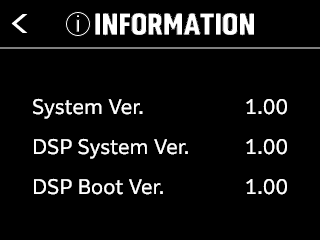
 on the SETTINGS Screen.
on the SETTINGS Screen.